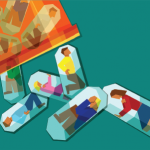 ACR Convergence 2020—In a desperate state last spring, the wife of a patient with myositis called social workers at the Hospital for Special Surgery, New York. Due to the COVID-19 pandemic, she had decided not to allow a home health aide—or anyone else—into the house to help care for her husband. She was tearful, overwhelmed and in emotional distress, said Adena Batterman, MSW, senior manager of the Inflammatory Arthritis Support and Education Programs, during an ACR Convergence 2020 session.
ACR Convergence 2020—In a desperate state last spring, the wife of a patient with myositis called social workers at the Hospital for Special Surgery, New York. Due to the COVID-19 pandemic, she had decided not to allow a home health aide—or anyone else—into the house to help care for her husband. She was tearful, overwhelmed and in emotional distress, said Adena Batterman, MSW, senior manager of the Inflammatory Arthritis Support and Education Programs, during an ACR Convergence 2020 session.
Held on Nov. 9, 2020, the session addressed the pandemic’s heavy psychosocial toll on those who contract COVID-19, patients with rheumatic diseases who are worried that their illness and immunosuppressive treatments place them at a higher risk for complications and caregivers for those with chronic illness. All of these issues require healthcare professionals to remain extra vigilant for signs of mental health issues and other psychosocial needs of patients, according to Ms. Batterman.
Research found depression has increased threefold since the start of the pandemic, and 40% of people have struggled with mental health or suicidality during the pandemic.1
Further a survey conducted from June 24–30 found that in the previous month, 10.7% of the respondents had seriously considered suicide.2 Reasons included the isolation stemming from stay-at-home guidelines, the increased stresses of daily life and concerns of already medically vulnerable people about becoming infected.
Ethnic minorities, the poor, those in dense housing areas and essential workers are among those who are particularly vulnerable to these psychosocial issues, Ms. Batterman reported.
All clinicians, she noted, should have a keen eye open for those who need to be referred to special resources, especially because medical encounters are down and fewer opportunities exist to direct people to needed care. Support groups, faith-based organizations, mental health support via telehealth, virtual Alcoholics Anonymous meetings to support sobriety and virtual exercise and mindfulness programs are available to help people experiencing extreme psychological distress and psychosocial issues. Although not a substitute for the services typically available, for some, these can be a valuable lifeline and resource for support and coping, Ms. Batterman said.
Healthcare professionals also need to remember to take care of themselves. “We are healthcare providers, and we are healers. This is challenging work emotionally and physically—even before COVID-19, but of paramount importance right now,” Ms. Batterman said. “I think we need to acknowledge this [fact] and allow this [experience] to be a reminder to practice self-compassion.”
Rehabilitation Support
Lisa Sheehy, PT, PhD, research associate at the Bruyere Research Institute, a healthcare and research organization in Ottawa, Canada, that provides rehabilitative services, said a relatively small percentage of people infected with COVID-19 will require physical rehabilitation of some kind. Based mostly on extrapolations from previous outbreaks of SARS and MERS, it’s predicted about half of hospitalized patients and two-thirds of intensive care unit (ICU) patients will need rehabilitation, with 4% requiring in-patient care, she said.
These patients may have such a range of needs that care can become complex. Patients can present with acute respiratory distress syndrome, septic shock, acute kidney injury and polyneuropathy—and these issues can overlap.
“You can see how varied this presentation can be,” Dr. Sheehy said. “Each person could have a whole constellation of symptoms affecting all different systems within the body.”
These patients can require training to increase respiratory muscle strength, slow and progressive aerobic conditioning, stroke rehabilitation, strength and balance work, and many other interventions.
“The most important thing is to do what rehabilitation professionals always do,” she said. “We need to create an individualized treatment plan based on a thorough assessment and consideration of the patient’s rehabilitation goals.”
Providing these services—while each location has its own needs and should consider procedures from a very local point of view—can involve reserving a separate floor, unit or even a separate facility for COVID-19 patients, especially because a patient can test positive even after receiving a negative result.
Depression has increased threefold since the start of the pandemic.
Other measures can include quarantine after arrival from acute care, staying physically distant in gyms if the space is large enough to share with other patients or, possibly, providing therapy in patients’ rooms.
Dr. Sheehy also suggested designating care partners, family or friends to help care for patients and engage with their rehabilitation for logistical and social support.
Create staff teams to help patients through rehabilitation. Continuous training and communication are crucial, because the dynamics, data and protocols for managing COVID-19 patients change so quickly.
“Personnel who work with these patients may have to adapt,” Dr. Sheehy said.
Thomas R. Collins is a freelance writer living in South Florida.
References
- Ettman CK, Abdalla SM, Cohen GH, et al. Prevalence of depression symptoms in U.S. adults before and during the COVID-19 pandemic. JAMA Netw Open. 2020 Sep 1;3(9):e2019686.
- Czeisler ME, Lane RI, Petrosky E, et al. Mental health, substance use and suicidal ideation during the COVID-19 pandemic: United States, June 24–30, 2020. MMWR Morb Mortal Wkly Rep. 2020 Aug 14;69(32):1049–1057.





